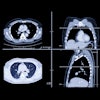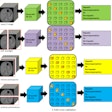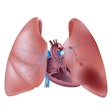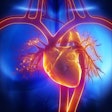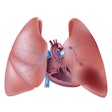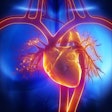
Men who regularly engage in high levels of physical activity are at an increased risk of having elevated CT coronary artery calcification (CAC) scores, but this association does not translate into a higher risk of all-cause mortality, according to research published online January 30 in JAMA Cardiology.
The group from various U.S. institutions examined the CT CAC scores and mortality rates of nearly 22,000 men who participated in the prospective Cooper Center Longitudinal Study. The researchers found that individuals with the highest level of physical activity were more likely to have a CT CAC score of at least 100 Agatston units (AU), compared with those with lower levels of activity.
However, among men with some calcification, more physical activity was associated with a decreased risk of cardiovascular disease and all-cause mortality.
"[The study] thus appears to provide evidence against the hypothesis that high levels of activity increase the risk of all-cause or cardiovascular disease mortality," wrote senior author Dr. Benjamin Levine from Texas Health Presbyterian Hospital and colleagues. "Our findings should reassure patients and their healthcare professionals that it appears these highly active individuals can safely continue their exercise programs."
'Hearts of stone'
It is well-known that routine physical activity substantially decreases an individual's risk of cardiovascular disease and all-cause mortality, but recent studies have reported diminishing returns with increasing volumes of activity, the authors noted. Taking these results one step further, some groups have raised the possibility that extreme levels of activity -- marathon running, for instance -- may not only promote cardiac fibrosis and coronary artery calcification but also increase mortality risk.
To address the concern that heavy endurance athletes were developing potentially fatal "hearts of stone," Levine and colleagues investigated the long-term effect of high levels of physical activity on the CT CAC scores and mortality rates of 21,758 healthy men with varying levels of self-reported activity. The participants' average age at the start of the trial was 51.7 years.
After a mean follow-up period of 10.4 years, the researchers reported the occurrence of 759 deaths from all causes and 180 fatalities due to cardiovascular disease. Among high-activity individuals, there were 40 deaths from all causes and 10 deaths from cardiovascular disease.
High-activity individuals who maintained at least 3,000 metabolic equivalent of task (MET) minutes of physical activity per week were 11% more likely to have a CT CAC score of at least 100 AU, compared with those who were less active. (An activity level of 3,000 MET-minutes/week roughly amounts to running 6.5 km per day or 300 minutes per week.)
Yet this increase in calcification on CT did not have a statistically significant association with increased cardiovascular disease or all-cause mortality risk, even after adjusting for age, body mass index, and smoking, among other factors. Rather, high-activity individuals had lower mortality rates than those with the lowest activity levels at any cutoff point of CT CAC.
| Effect of increasing CT CAC and physical activity on mortality rates | ||||||
| Hazard ratio | < 1,500 MET-min/wk | 1,500-2,999 MET-min/wk | ≥ 3,000 MET-min/wk | |||
| CT CAC < 100 AU | CT CAC ≥ 100 AU | CT CAC < 100 AU | CT CAC ≥ 100 AU | CT CAC < 100 AU | CT CAC ≥ 100 AU | |
| All-cause mortality | 1 | 1 | 0.78 | 0.87 | 0.52 | 0.77 |
| Cardiovascular disease mortality | 1 | 1 | 0.66 | 0.66 | 0.39 | 0.8 |
Although the researchers did find that a higher prevalence of calcium was associated with a higher risk of mortality, there was no evident association between the highest levels of physical activity and increased mortality rates. On the contrary, high levels of physical activity nearly halved the risk of all-cause mortality (hazard ratio of 0.52) in men with a CT CAC score of less than 100 AU.
Safe to exercise
"Despite the fact that this type of high-volume physical activity and exercise may promote calcific coronary atherosclerosis, it appears to still be associated with safety and possibly lower mortality risks," Dr. Carl Lavie from the University of Queensland and colleagues wrote in an accompanying editorial.
Nonetheless, high CT CAC scores were still associated with a slightly higher risk of cardiovascular disease at each level of physical activity, underscoring the importance of CT CAC risk-assessment testing, they noted.
Lavie and colleagues additionally recommended CT CAC testing for high-activity individuals with an intermediate risk of heart disease, followed by more intense lipid intervention and other preventive therapies for those found to have a score of at least 100 AU or be in the 75th percentile for their age group.
"[CT] CAC testing appears to retain its utility in high-volume exercisers, and along with cardiorespiratory fitness is a very important predictor associated with survival," they wrote.
